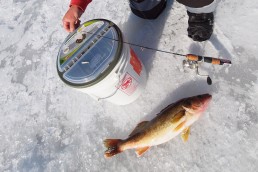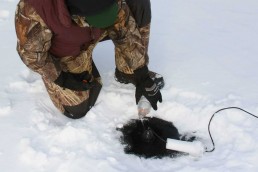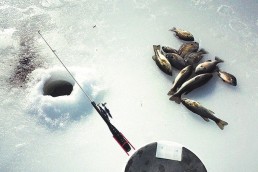Stay Stealthy on Early Ice
SHARE THIS POST
Get the bite, save the commotion
Who, me? A believer in hocus-pocus? Not really. But, I can easily understand why early winter is such a magical time of year for most anglers. Catching walleyes, pike and panfish becomes much simpler as soon as the lake exterior solidifies. Plus, it stays that way for quite a few weeks to come. But, even something as grand as a great bite can turn bad quickly if you don’t pay attention to the commotion you’re making while fishing. There’s no snow this time of year to muffle your sound, you must stay stealthy or you’ll spook fish. If you’ve scared the fish out from underneath you, you won’t go home with anything to show for your fishing. Nothing more than frigid fingers and the can of baked beans you had to buy for the dinner table. Plus, a bad attitude. Too late to stay stealthy.
Here, there, just not anywhere
The primary key to success early in the season is knowing where, exactly, to drop a line. If you do, you won’t create chaos by moving throughout the day and spooking fish. And, if you did any fishing (better yet catching) this past fall, you already know where to go. Early in the ice-fishing season, I want to get to the place I caught fish last fall, first. The fish haven’t left. More may have shown up since I was able to launch my Lund or wade in open water.
Wade, you question? Yes, wade. You see, the late-fall period was the time of year the fish fed in shallow water. All were within easy casting distance of an angler walking the shallows in waders. It’s in these same areas, sometimes just steps from the shoreline, where I find fish at first ice if I stay stealthy.
We’ve cracked the crappie code. Read up and prepare to reel ’em in.
The word on weeds
I first probe the areas along the outer edges of the weed beds, closest to points. Especially when they’re adjacent to deep water. I likely caught fish there right before the freeze. These outer weed lines usually occur along a breakline (aka: drop off), no matter how slight the depth change might be.
Breaklines are easy to find when using mapping from Navionics. An SD card filled with hydrographic maps in my Lowrance HOOK-5 Ice Machine shows me where the breaklines in a particular waterway are. This is imperative when it comes to walking directly to my fishing spot. I can drill holes immediately over prime water and minimize commotion throughout the day.
Stay stealthy on the move
More than likely, the ice is still too thin to support my quad or snowmobile. I hoof it, rather than drive. If I can get away without ice cleats over the soles of my boots, all the better. The noise from ice cleats scraping and digging into the ice reverberates tenfold under the water and gives my whereabouts to the fish. Instead, I don boots with a soft yet aggressive rubber tread built right in to provide superior grip on the ice. My boots need to be 100 percent waterproof to keep my feet dry when water splashes up and out of the hole when I bore a hole with my auger.
Are you enjoying this post?
You can be among the first to get the latest info on where to go, what to use and how to use it!
Speaking of augers, I make sure the blades of my StrikeMaster Lazer Synthetic Ultra-Lite or StrikeMaster power auger are razor-sharp. I want to bore as many holes as possible in a short period of time, quickly and efficiently. This way, I can keep the uproar later in the day to a minimum.
Before my blades dull, however, I’ll purchase replacement blades to always have another set on hand in case I damage the originals. Dull auger blades are really frustrating when ice fishing, yet few anglers think about bringing along spares.
Cover me, I’m going in
Once I have drilled several holes, checked the depth and looked for fish at each one, it’s time to lower a line. But, even while fishing, I stay as quiet as possible. First off, I deploy my tip-ups, hooking up minnows fresh from my Plano minnow bucket. Next, I erect my Clam X200 Pro Thermal two-man ice shelter. Not only to stay warm while inside its thick, insulated walls, but also to keep my silhouette shaded while on the thinner, clear ice.
Tip: Lay a piece of carpeting down on the ice beneath your feet to muffle any sound your boots make as you shuffle around. This keeps your feet warmer, too. Hear that? I didn’t think so. If you’re looking to catch more fish early in the ice season, then take every measure to stay as stealthy as possible. While wearing stealthy, warm footwear with good traction, walk directly to the spot you last caught fish before the lake froze. Drill as many holes as you can muster. Set those tip-ups, and then get inside a portable shanty.
Keep your commotion to a minimum and, I promise, you’ll catch more fish.
Editor’s note: Mark Martin is a professional walleye tournament angler and instructor with the Ice-Fishing Vacation/School, with new classes on ice starting up in January 2018. For more information on Mark, any of the items mentioned in this article or the school, visit his website at markmartins.net.
MWO
SHARE THIS POST
Did you enjoy this post?
You can be among the first to get the latest info on where to go, what to use and how to use it!
Mark Martin
Mark Martin is a professional walleye tournament angler and instructor with the Ice Fishing School/Vacation series. For more information, check out his website at markmartins.net or fishingvacationschool.com.



